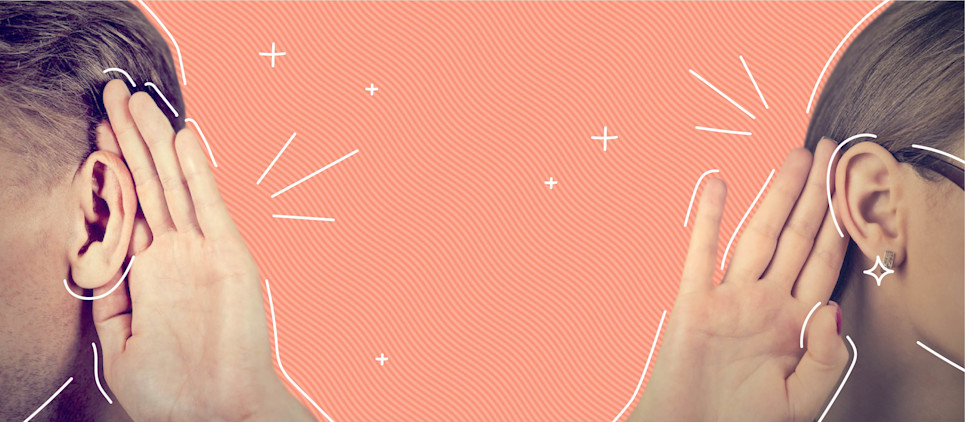The best ways to improve your active listening skills
Few things in life are more frustrating than trying to communicate with someone who clearly isn’t paying attention to you. You’re more likely to give up on a conversation when someone is avoiding eye contact and saying, “Uh-huh.”
On the other hand, it’s just as obvious when you have someone’s full attention. They're focused on what you have to say, and you're both more likely to leave the conversation satisfied as a result. Good listening skills are essential for communication in the workplace as well as in your interpersonal relationships.

Table of contents
What does active listening sound like?What is active listening?4 Benefits of active listening 4 Ways to improve your active listening skillsWhat does active listening sound like?
While nonverbal communication is an essential part of active listening, there are also some specific words and phrases that can help someone feel heard. For a good example of an active listener in action, try listening to a podcast like The Daily from The New York Times. The host, Michael Barbaro, employs excellent active listening skills while he’s interviewing his subjects. Some phrases you’ll hear a good active listener like Barbaro use include:
“So what I hear you saying is…”
“Would it be accurate to say that you....”
“Now, correct me if I’m wrong, but it seems like…”
“What would you think if I said…”
“I just want to make sure I’m understanding you correctly.”
“I’m sorry, I didn’t understand that last part.”
“It’s almost like you could say that…”
“And what happened next?”
What does someone who’s disinterested in the conversation sound like? While it’s good to leave room in the conversation for the person speaking, too much silence can make the speaker uncomfortable. You can also show that you’re listening but not going to interject and interrupt by making affirmative sounds with your voice like “mmhmm,” during salient moments in the conversation. Try to stay away from short, one-word answers and questions and vague platitudes like:
“What?”
“Um, I don’t know.”
“Sounds like your problem.”
“I just don’t know what to tell you.”
“It is what it is.”
What is active listening?
Active listening involves paying attention to the speaker. It’s essentially a combination of facial expressions, body language, and verbal cues that tell someone you’re listening. Nodding your head is an example of a gesture that silently lets someone know you’re engaged.
Passive listening, on the other hand, is a failure to react to the person speaking and a lack of verbal affirmations, like when you’re sitting in the audience or listening to a podcast. No one enjoys a one-sided conversation in which the silent party looks bored to death. That’s why learning how to be an active listener is crucial to developing effective communication skills.
4 Benefits of active listening
1. Helps the conversation flow more smoothly
Practicing active listening should feel like taking turns as you keep the conversation in balance, moving from topic to topic. Imagine a tennis match: You need both players volleying the ball back and forth to keep the game going.
2. Helps you retain information better
A 2015 study found that good students use a variety of active listening skills to succeed in academic environments. Try processing information using more than one learning technique. Taking notes while listening helps create more connections in your brain to reinforce the memories associated with the information. Talking or writing about new information can also make you more likely to remember it.
3. Makes people feel good
A Harvard Business Review study found that effective listening interactions can help build self-esteem. It makes sense: People appreciate being heard and feel good as a result. Active listening can help you build trust with the people in your life, whether a business connection, friend, or family member.
4. Can lead to problem-solving
Humans are inherently social, and we crave the ability to solve problems, whether emotional or logistical, with another person. Just speaking our thoughts out loud can allow us to see them from a different angle. Getting another person’s perspective and wisdom can help us see new possibilities and solutions.

4 Ways to improve your active listening skills
1. Hold space for the speaker emotionally and physically
At the beginning of the conversation, honor the speaker by shifting your focus to them. Take a moment to put your phone away and remove other distractions. Face your conversation partner and maintain eye contact. Feel your attention turning to the conversation and away from your own thoughts or observations about the physical space surrounding you.
2. Participate in the conversation
Being an attentive listener is about more than just hearing the person speaking. It’s important to pause occasionally to summarize their key points and ask clarifying questions. Often, people want to talk not simply to communicate information, but to process their own thoughts and feelings about a topic. Provide a space for them to do so by asking open-ended questions that begin with “how” or “why.”
3. Add a personal touch
Some people find it annoying when listeners hijack the conversation with a story of their own. But the HBR study found that adding suggestions or relating to the speaker by relaying your own experience can be helpful.
Use the speaker’s nonverbal cues to gauge how your approach is being received. The goal is to process information and understand the speaker’s feelings, not to steal the spotlight. They might start looking away, speaking less, or physically shrinking within the space.
4. Don’t be a perfectionist
Interpersonal communication is a delicate art that we spend our entire lives practicing. Some people are naturally tuned in to the rhythm of conversation. Others need more practice to be able to better identify verbal and non-verbal cues.
You might feel unnatural or awkward at first, and that’s to be expected. Adding active listening to your toolkit of interpersonal skills can be especially challenging because every person is unique. One speaker’s body language might be totally different from the next’s.
Active listening is a soft skill that helps build trust between colleagues, roommates, friends, and family members. Now that you know how to be an attentive listener, you have an opportunity to practice nearly every day.
Bungalow housing is made for roommates. We handpick homes that are move-in ready and perfect for shared living, and with roommate vetting and compatibility matching, we help you find people you actually want to live with. Find your Bungalow.
Ready to find your next home?
Move-in ready homes and a built-in community so you can feel at home, together — wherever you are.
Suggested articles



